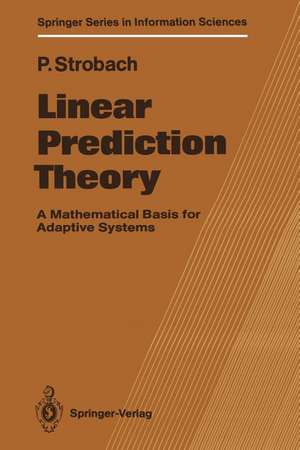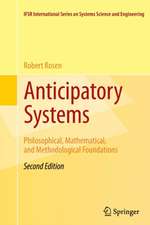Linear Prediction Theory: A Mathematical Basis for Adaptive Systems: Springer Series in Information Sciences, cartea 21
Autor Peter Strobachen Limba Engleză Paperback – 27 dec 2011
Din seria Springer Series in Information Sciences
- 20%
 Preț: 337.66 lei
Preț: 337.66 lei - 18%
 Preț: 955.08 lei
Preț: 955.08 lei - 15%
 Preț: 646.62 lei
Preț: 646.62 lei - 20%
 Preț: 337.52 lei
Preț: 337.52 lei -
 Preț: 385.62 lei
Preț: 385.62 lei -
 Preț: 381.98 lei
Preț: 381.98 lei -
 Preț: 391.61 lei
Preț: 391.61 lei - 20%
 Preț: 324.64 lei
Preț: 324.64 lei -
 Preț: 380.84 lei
Preț: 380.84 lei - 18%
 Preț: 777.69 lei
Preț: 777.69 lei -
 Preț: 387.96 lei
Preț: 387.96 lei - 20%
 Preț: 330.75 lei
Preț: 330.75 lei -
 Preț: 382.57 lei
Preț: 382.57 lei - 15%
 Preț: 642.18 lei
Preț: 642.18 lei - 15%
 Preț: 640.06 lei
Preț: 640.06 lei -
 Preț: 387.58 lei
Preț: 387.58 lei - 20%
 Preț: 333.40 lei
Preț: 333.40 lei -
 Preț: 386.99 lei
Preț: 386.99 lei - 20%
 Preț: 653.71 lei
Preț: 653.71 lei - 15%
 Preț: 661.02 lei
Preț: 661.02 lei - 18%
 Preț: 1391.21 lei
Preț: 1391.21 lei - 15%
 Preț: 638.43 lei
Preț: 638.43 lei - 15%
 Preț: 642.68 lei
Preț: 642.68 lei -
 Preț: 386.00 lei
Preț: 386.00 lei - 20%
 Preț: 649.60 lei
Preț: 649.60 lei - 18%
 Preț: 950.21 lei
Preț: 950.21 lei -
 Preț: 393.35 lei
Preț: 393.35 lei - 20%
 Preț: 652.41 lei
Preț: 652.41 lei - 20%
 Preț: 645.65 lei
Preț: 645.65 lei -
 Preț: 390.25 lei
Preț: 390.25 lei -
 Preț: 387.96 lei
Preț: 387.96 lei - 15%
 Preț: 580.97 lei
Preț: 580.97 lei
Preț: 396.62 lei
Nou
Puncte Express: 595
Preț estimativ în valută:
75.90€ • 81.16$ • 63.28£
75.90€ • 81.16$ • 63.28£
Carte tipărită la comandă
Livrare economică 17 aprilie-01 mai
Preluare comenzi: 021 569.72.76
Specificații
ISBN-13: 9783642752087
ISBN-10: 364275208X
Pagini: 444
Ilustrații: XVI, 422 p.
Dimensiuni: 155 x 235 x 23 mm
Greutate: 0.62 kg
Ediția:Softcover reprint of the original 1st ed. 1990
Editura: Springer Berlin, Heidelberg
Colecția Springer
Seria Springer Series in Information Sciences
Locul publicării:Berlin, Heidelberg, Germany
ISBN-10: 364275208X
Pagini: 444
Ilustrații: XVI, 422 p.
Dimensiuni: 155 x 235 x 23 mm
Greutate: 0.62 kg
Ediția:Softcover reprint of the original 1st ed. 1990
Editura: Springer Berlin, Heidelberg
Colecția Springer
Seria Springer Series in Information Sciences
Locul publicării:Berlin, Heidelberg, Germany
Public țintă
ResearchCuprins
1. Introduction.- 2. The Linear Prediction Model.- 2.1 The Normal Equations of Linear Prediction.- 2.2 Geometrical Interpretation of the Normal Equations.- 2.3 Statistical Interpretation of the Normal Equations.- 2.4 The Problem of Signal Observation.- 2.5 Recursion Laws of the Normal Equations.- 2.6 Stationarity — A Special Case of Linear Prediction.- 2.7 Covariance Method and Autocorrelation Method.- 2.8 Recursive Windowing Algorithms.- 2.9 Backward Linear Prediction.- 2.10 Chapter Summary.- 3. Classical Algorithms for Symmetric Linear Systems.- 3.1 The Cholesky Decomposition.- 3.2 The QR Decomposition.- 3.3 Some More Principles for Matrix Computations.- 3.4 Chapter Summary.- 4. Recursive Least-Squares Using the QR Decomposition.- 4.1 Formulation of the Growing-Window Recursive Least-Squares Problem.- 4.2 Recursive Least Squares Based on the Givens Reduction.- 4.3 Systolic Array Implementation.- 4.4 Iterative Vector Rotations — The CORDIC Algorithm.- 4.5 Recursive QR Decomposition Using a Second-Order Window.- 4.6 Alternative Formulations of the QRLS Problem.- 4.7 Implicit Error Computation.- 4.8 Chapter Summary.- 5. Recursive Least-Squares Transversal Algorithms.- 5.1 The Recursive Least-Squares Algorithm.- 5.2 Potter’s Square-Root Normalized RLS Algorithm.- 5.3 Update Properties of the RLS Algorithm.- 5.4 Kubin’s Selective Memory RLS Algorithms.- 5.5 Fast RLS Transversal Algorithms.- 5.6 Descent Transversal Algorithms.- 5.7 Chapter Summary.- 6. The Ladder Form.- 6.1 The Recursion Formula for Orthogonal Projections.- 6.2 Computing Time-Varying Transversal Predictor Parameters from the Ladder Reflection Coefficients.- 6.3 Stationary Case — The PARCOR Ladder Form.- 6.4 Relationships Between PARCOR Ladder Form and Transversal Predictor.- 6.5 The Feed-BackPARCOR Ladder Form.- 6.6 Frequency Domain Description of PARCOR Ladder Forms.- 6.7 Stability of the Feed-Back PARCOR Ladder Form.- 6.8 Burg’s Harmonic Mean PARCOR Ladder Algorithm.- 6.9 Determination of Model Order.- 6.10 Chapter Summary.- 7. Levinson-Type Ladder Algorithms.- 7.1 The Levinson-Durbin Algorithm.- 7.2 Computing the Autocorrelation Coefficients from the PARCOR Ladder Reflection Coefficients — The “Inverse” Levinson-Durbin Algorithm.- 7.3 Some More Properties of Toeplitz Systems and the Levinson-Durbin Algorithm.- 7.4 Split Levinson Algorithms.- 7.5 A Levinson-Type Least-Squares Ladder Estimation Algorithm.- 7.6 The Makhoul Covariance Ladder Algorithm.- 7.7 Chapter Summary.- 8 Covariance Ladder Algorithms.- 8.1 The LeRoux-Gueguen Algorithm.- 8.2 The Cumani Covariance Ladder Algorithm.- 8.3 Recursive Covariance Ladder Algorithms.- 8.4 Split Schur Algorithms.- 8.5 Chapter Summary.- 9. Fast Recursive Least-Squares Ladder Algorithms.- 9.1 The Exact Time-Update Theorem of Projection Operators.- 9.2 The Algorithm of Lee and Morf.- 9.3 Other Forms of Lee’s Algorithm.- 9.4 Gradient Adaptive Ladder Algorithms.- 9.5 Lee’s Normalized RLS Ladder Algorithm.- 9.6 Chapter Summary.- 10. Special Signal Models and Extensions.- 10.1 Joint Process Estimation.- 10.2 ARMA System Identification.- 10.3 Identification of Vector Autoregressive Processes.- 10.4 Parametric Spectral Estimation.- 10.5 Relationships Between Parameter Estimation and Kalman Filter Theory.- 10.6 Chapter Summary.- 11. Concluding Remarks and Applications.- A.1 Summary of the Most Important Forward/Backward Linear Prediction Relationships.- A.2 New PORLA Algorithms and Their Systolic Array Implementation.- A.3 Vector Case of New PORLA Algorithms.














